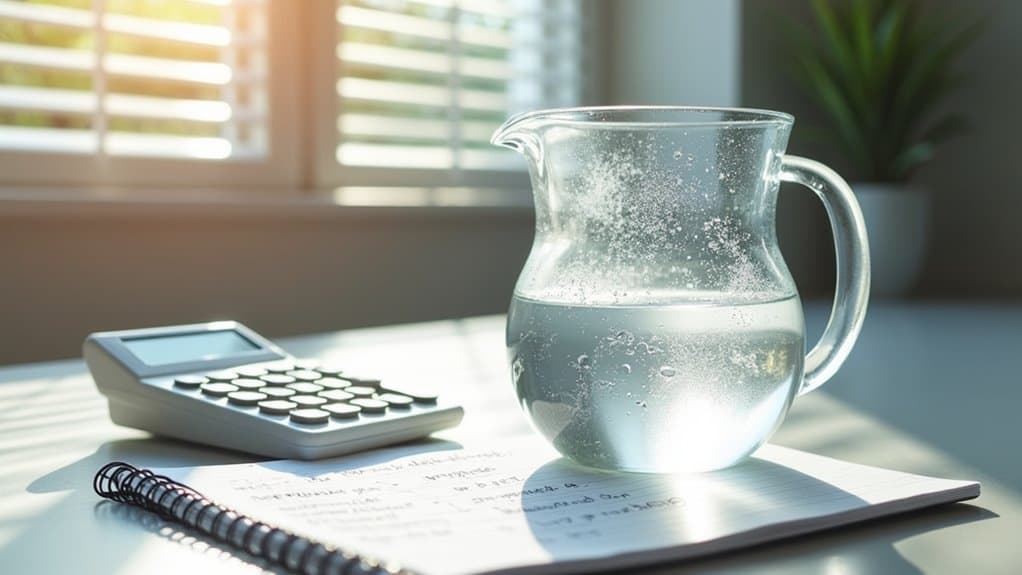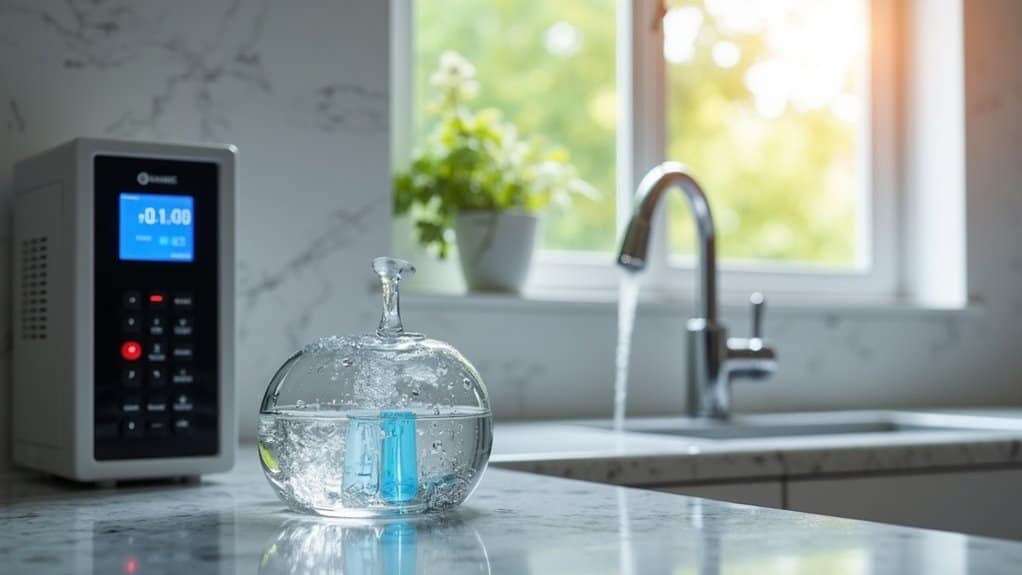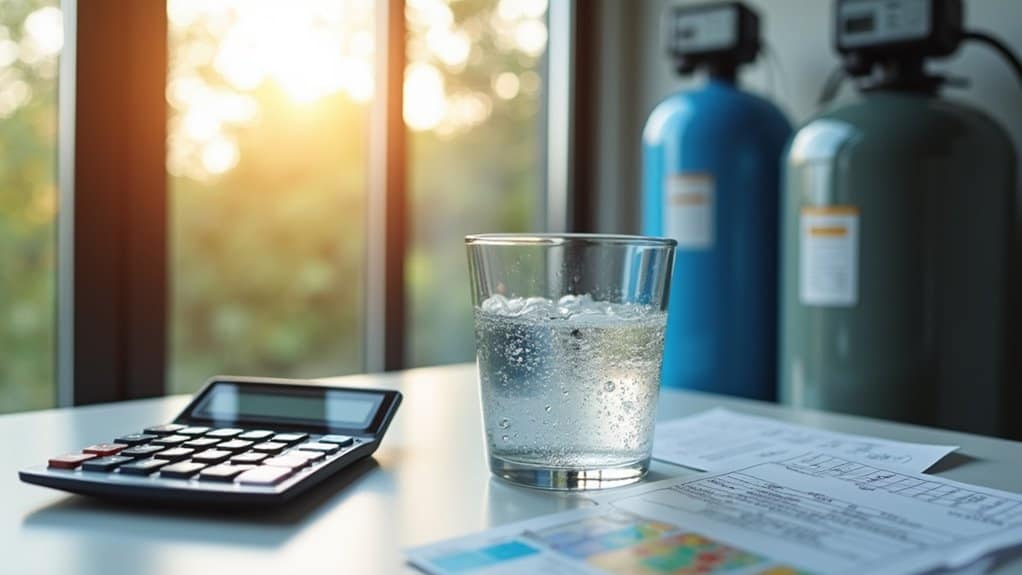Finding your perfect water softener size requires calculating your daily grain requirement. We multiply your water hardness (GPG) by your household’s daily water usage (gallons). For example, a family of four using 320 gallons with 5 GPG hardness needs a 1,600 grain/day system. Don’t forget to factor in iron content and peak usage periods. The right size ensures optimal performance, longer system life, and lower operating costs.
Key Takeaways
- Calculate your daily grain requirement by multiplying water hardness (GPG) by total household water consumption.
- Determine your water hardness through testing, converting mg/L to GPG by dividing by 17.1.
- Account for household size, with larger families requiring higher capacity systems (32,000-48,000 grains for 3-4 people).
- Consider peak usage periods and special water conditions like iron content when sizing your system.
- Proper sizing prevents system overwhelm, extends resin life, and optimizes salt and water usage efficiency.
Why Proper Water Softener Sizing Matters for Your Home

When selecting a water softener for your home, proper sizing matters more than any other factor for ensuring optimal performance and value.
We’ve found that correctly sized systems deliver consistent zero-grain water output while preventing mineral buildup in your plumbing. Additionally, using a reliable approach to sizing can simplify the selection process and provide peace of mind.
They balance flow rates with your household’s simultaneous water demands, ensuring you’ll never experience pressure drops during peak usage times.
Proper sizing also optimizes regeneration cycles, extending resin life while minimizing salt and water consumption. This prevents the financial drain of premature maintenance, appliance damage, and excessive resource use that plague improperly sized units.
The difference is clear: precise sizing equals better performance, lower operating costs, and longer system life. Understanding your water hardness measurement is crucial for accurate sizing calculations that deliver reliable performance.
How to Calculate Your Household’s Daily Grain Requirement

Calculating your household’s daily grain requirement forms the foundation of proper water softener sizing.
We use a simple formula: multiply your water hardness (GPG) by total daily consumption. For a typical family of four using 320 gallons daily with water hardness of 5 GPG, that’s 1,600 grains/day. Additionally, DIY methods can help you determine the most accurate measurements for your specific situation. Convert lab results from mg/L to GPG by dividing by 17.1. Don’t forget to account for contaminants—each 1 mg/L of iron adds 5 GPG to your calculation.
Plan for peak usage periods to ensure your system won’t be overwhelmed during high-demand times. Unlike the creditable grains requirements for school meals, water softener grain calculations refer to hardness removal capacity.
Matching Water Hardness Levels to the Right Softener Capacity

Three critical factors determine the appropriate water softener capacity for your home: water hardness level, household size, and daily consumption patterns.
For soft water (0-3 GPG), minimal softening is required.
Moderately hard water (4-10 GPG) typically needs 16,000-32,000 grain systems for 1-2 person households.
Hard water (11-15 GPG) demands 24,000-48,000 grains for 3-4 people, while very hard water (16+ GPG) requires 40,000+ grain capacity. Consider that these recommendations account for your system needing to remove daily grain loads calculated by multiplying your water usage by hardness level.
We recommend checking your local water reports or using test kits to verify hardness levels.
For extreme cases exceeding 50 GPG, specialized systems of 80,000+ grains are necessary.
Common Sizing Mistakes That Cost Homeowners Money and Efficiency

Many homeowners unknowingly sabotage their water softening systems through improper sizing, leading to wasted money and reduced efficiency.
We’ve identified the most costly errors when calculating softener requirements.
- Underestimating peak usage – Failing to account for simultaneous appliance use and guest visits creates capacity shortfalls.
- Skipping water hardness testing – Relying on assumptions instead of accurate measurements leads to inappropriate sizing. Testing is essential as water hardness varies significantly from soft to hard water classifications. An undersized softener can result in appliance damage due to inadequate hardness removal.
- Miscalculating daily consumption – Overlooking new appliances, seasonal demands, and peak usage scenarios.
- Neglecting regeneration efficiency – Choosing time-based systems over demand-initiated models increases salt and water waste.
Frequently Asked Questions
Should I Add Capacity for Future Home Additions or Family Growth?
We absolutely recommend adding capacity for future growth. When sizing your water softener, we factor in potential household expansions to prevent premature system replacement and ensure continued efficiency.
How Does Water Softener Size Affect Salt Consumption and Efficiency?
We’ve found that larger softeners consume more salt per regeneration while regenerating less frequently. The ideal size balances these factors, maximizing efficiency through proper salt dosing and demand-based regeneration cycles.
Can I Install Different Sized Units in a Multi-Unit Property?
Yes, we can install different sized water softeners across multi-unit properties. We’ll need to account for varied unit demands, plumbing configurations, and potential efficiency trade-offs compared to centralized systems.
Do Vacation Homes Require Differently Sized Water Softeners?
Yes, vacation homes need specialized sizing. We’ll adjust for intermittent usage patterns, recommending units that handle concentrated demand during occupancy while extending regeneration cycles during vacant periods to maximize efficiency and system longevity.
How Often Should I Recalculate My Water Softener Size Requirements?
We recommend recalculating softener requirements annually, after significant household changes, or whenever water hardness shifts by >5 GPG. Well water users should reassess quarterly due to greater fluctuation potential.
Conclusion
We’ve provided the essential formula for proper water softener sizing: multiply your daily water usage by water hardness level, then add 3-5 GPG for iron if present. By selecting a system that accommodates your specific grain requirement, you’ll maximize efficiency, extend your softener’s lifespan, and avoid unnecessary expenses. Don’t fall into common sizing pitfalls—use our calculator to determine the optimal capacity for your household’s needs.

Craig “The Water Guy” Phillips is the founder of Quality Water Treatment (QWT) and creator of SoftPro Water Systems.
With over 30 years of experience, Craig has transformed the water treatment industry through his commitment to honest solutions, innovative technology, and customer education.
Known for rejecting high-pressure sales tactics in favor of a consultative approach, Craig leads a family-owned business that serves thousands of households nationwide.
Craig continues to drive innovation in water treatment while maintaining his mission of “transforming water for the betterment of humanity” through transparent pricing, comprehensive customer support, and genuine expertise.
When not developing new water treatment solutions, Craig creates educational content to help homeowners make informed decisions about their water quality.


